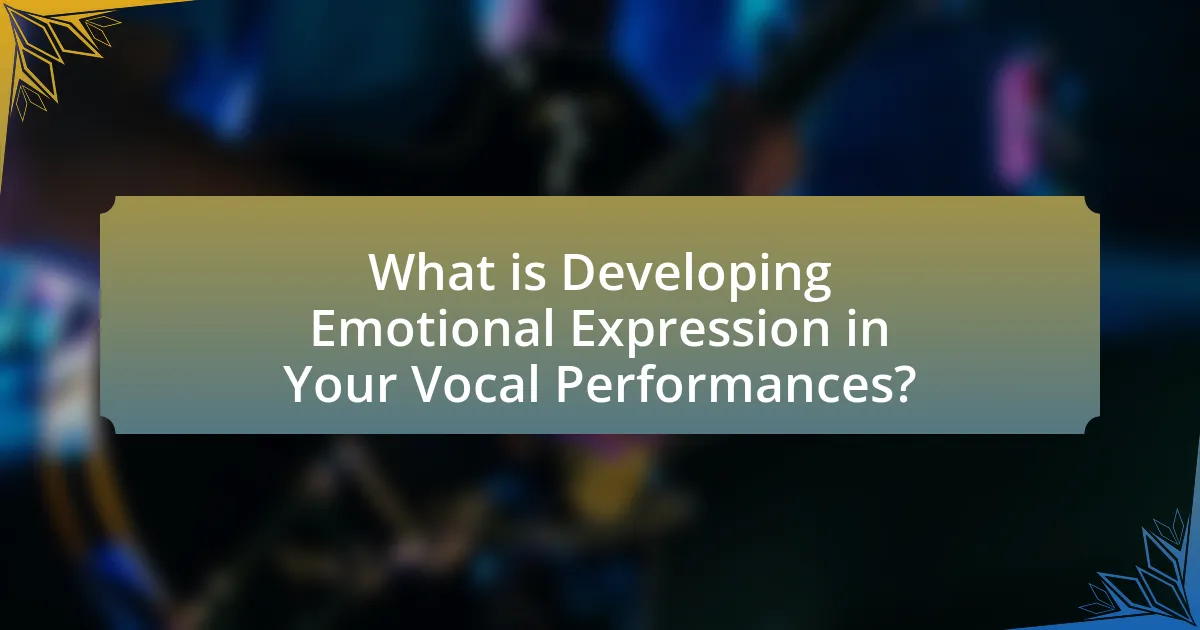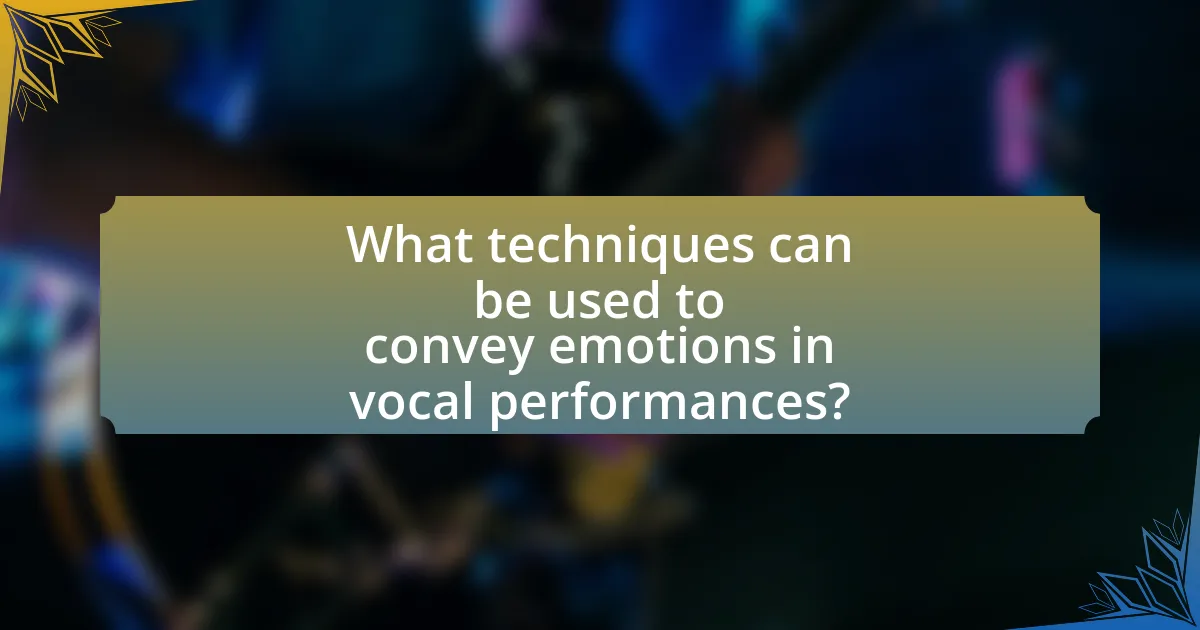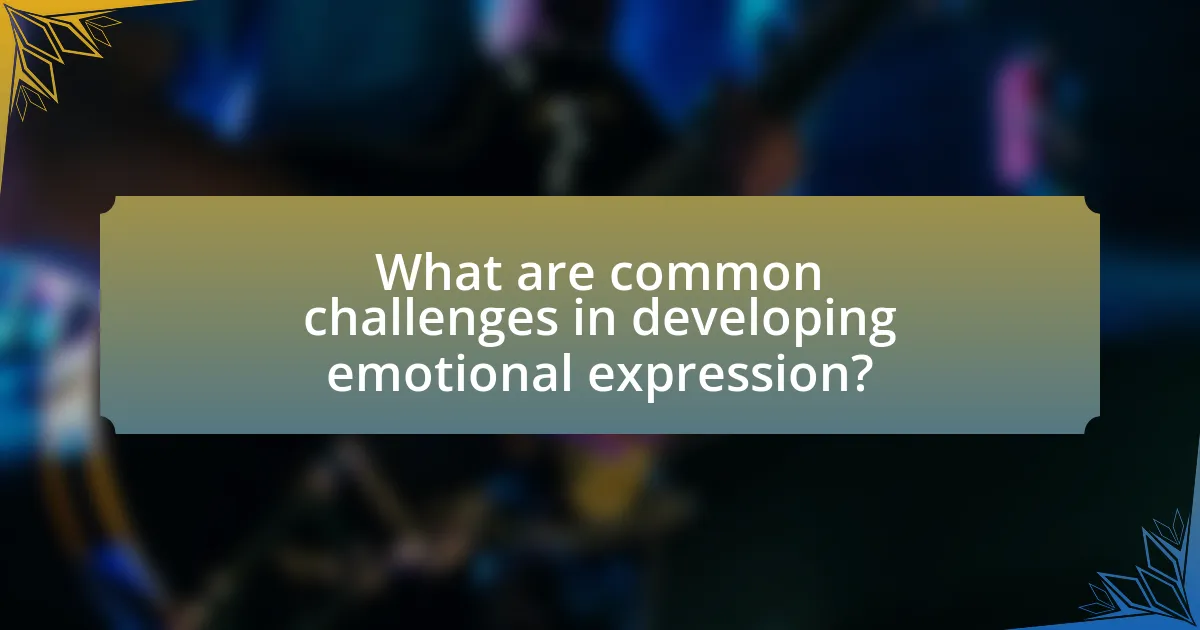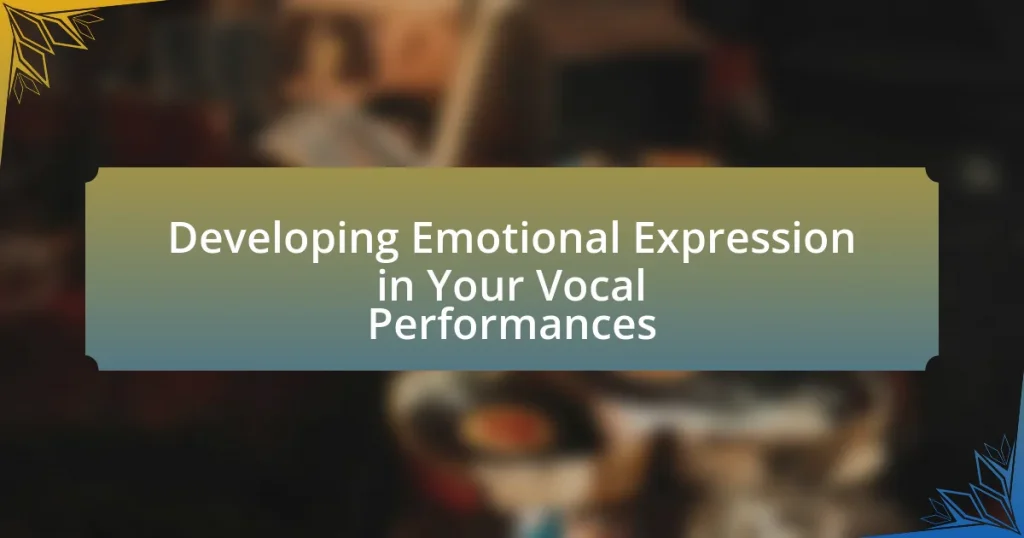Developing emotional expression in vocal performances is the ability of singers to convey feelings through their voice, enhancing audience engagement and connection. Key elements include vocal tone, dynamics, phrasing, and lyrical interpretation, which work together to create a compelling emotional experience. Techniques such as emotional visualization, character immersion, and dynamic vocal exercises can help singers explore and express a range of emotions. Additionally, understanding the significance of body language, song selection, and feedback can further improve emotional delivery in performances. Common challenges include technical limitations and performance anxiety, which can be addressed through mindful practices and peer reviews.

What is Developing Emotional Expression in Your Vocal Performances?
Developing emotional expression in vocal performances refers to the ability of a singer to convey feelings and emotions through their voice, enhancing the overall impact of the performance. This involves techniques such as dynamic control, phrasing, and tonal variation, which allow the performer to connect with the audience on an emotional level. Research indicates that emotional expression in music can significantly influence listener perception and engagement, as demonstrated in studies showing that audiences respond more positively to performances that effectively convey emotion.
Why is emotional expression important in vocal performances?
Emotional expression is crucial in vocal performances because it enhances the connection between the performer and the audience. This connection is vital for engaging listeners and conveying the intended message of the song or piece. Research indicates that performances infused with genuine emotional expression can lead to a more profound audience response, as emotions can be contagious and resonate with listeners on a personal level. For example, a study published in the journal “Psychology of Music” found that singers who effectively express emotions through their voice can significantly influence the emotional reactions of their audience, leading to increased enjoyment and memorability of the performance.
How does emotional expression enhance audience connection?
Emotional expression enhances audience connection by fostering empathy and relatability. When performers convey genuine emotions, audiences are more likely to resonate with the message, creating a shared experience. Research indicates that emotional expression can activate mirror neurons in the brain, which facilitate emotional understanding and connection. For instance, a study published in the journal “Emotion” by Decety and Jackson (2004) demonstrates that observing emotional expressions can lead to increased feelings of empathy in viewers. This empathetic response strengthens the bond between the performer and the audience, making the performance more impactful and memorable.
What role does emotional expression play in storytelling through music?
Emotional expression is crucial in storytelling through music as it enhances the listener’s connection to the narrative. When musicians convey emotions through melody, harmony, and dynamics, they create an immersive experience that allows audiences to empathize with the characters and situations depicted in the music. Research indicates that emotional expression in music can evoke specific feelings and memories, reinforcing the storytelling aspect. For example, studies show that music with a minor key often elicits sadness, while major keys can evoke happiness, demonstrating how emotional cues guide the listener’s interpretation of the story being told.
What are the key elements of emotional expression in singing?
The key elements of emotional expression in singing include vocal tone, dynamics, phrasing, and lyrical interpretation. Vocal tone conveys the singer’s feelings, with variations in timbre reflecting different emotions; for instance, a bright tone may express joy, while a darker tone can indicate sadness. Dynamics, or the variations in loudness, enhance emotional impact; softer passages can evoke intimacy, while louder sections can convey passion or urgency. Phrasing involves the way a singer shapes musical lines, allowing for emotional nuances through breath control and articulation. Lastly, lyrical interpretation requires understanding the song’s message and conveying it authentically, which can significantly influence the audience’s emotional response. These elements work together to create a compelling emotional experience for listeners.
How do dynamics contribute to emotional expression?
Dynamics significantly enhance emotional expression by varying the intensity and volume of vocal performances. These changes in dynamics allow performers to convey different feelings, such as excitement, sadness, or tension, effectively engaging the audience. For instance, a soft, gentle tone can evoke vulnerability, while a powerful, loud delivery can express anger or passion. Research indicates that listeners can accurately interpret emotions based on dynamic variations in music, demonstrating that dynamics are crucial for emotional communication in vocal performances.
What is the significance of vocal tone in conveying emotions?
Vocal tone is significant in conveying emotions because it directly influences how a message is perceived by listeners. Research indicates that variations in pitch, volume, and timbre can evoke specific emotional responses; for instance, a higher pitch often conveys excitement or happiness, while a lower pitch may suggest sadness or seriousness. Studies, such as those by Juslin and Laukka (2003), demonstrate that listeners can accurately identify emotions based solely on vocal tone, highlighting its critical role in emotional expression. This ability to interpret emotions through vocal tone underscores its importance in effective communication and performance.
How can singers identify their emotional range?
Singers can identify their emotional range by exploring various musical genres and performing pieces that evoke different feelings. Engaging with diverse songs allows singers to experience and express a wide array of emotions, from joy to sadness, anger to tranquility. Research indicates that emotional expression in music is linked to the singer’s ability to connect with the lyrics and the music’s emotional context, enhancing their interpretative skills. By regularly practicing and reflecting on their emotional responses during performances, singers can better understand their emotional range and how to convey it effectively to their audience.
What techniques can help singers explore different emotions?
Singers can explore different emotions through techniques such as emotional visualization, character immersion, and dynamic vocal techniques. Emotional visualization involves singers imagining specific scenarios or memories that evoke the desired emotion, allowing them to connect deeply with the song’s message. Character immersion requires singers to embody the persona of the song’s narrative, which enhances emotional authenticity. Dynamic vocal techniques, including varying pitch, volume, and tempo, enable singers to express a range of feelings effectively. Research indicates that these methods can significantly enhance emotional delivery in performances, as evidenced by studies showing that performers who engage in emotional visualization report a stronger connection to their music and audience.
How does self-awareness impact emotional expression in performances?
Self-awareness significantly enhances emotional expression in performances by enabling performers to recognize and understand their own emotions, which in turn allows for more authentic and relatable portrayals. When performers are self-aware, they can identify their emotional triggers and effectively channel those feelings into their performances, resulting in a deeper connection with the audience. Research indicates that self-awareness is linked to improved emotional regulation, which helps performers manage their emotions and express them more clearly. For instance, a study published in the Journal of Applied Psychology found that individuals with higher self-awareness demonstrated greater emotional intelligence, leading to more impactful communication and performance outcomes.
How can vocalists practice emotional expression effectively?
Vocalists can practice emotional expression effectively by using techniques such as visualization, character immersion, and dynamic vocal exercises. Visualization involves imagining the emotions behind the lyrics, which helps in conveying genuine feelings during performance. Character immersion requires vocalists to embody the persona of the song, allowing them to connect deeply with the emotional context. Dynamic vocal exercises, such as varying pitch, volume, and tempo, can enhance the emotional delivery by mimicking the natural fluctuations of human emotion. Research indicates that these methods can significantly improve a vocalist’s ability to express emotions, as they engage both the mind and body in the performance process.
What exercises can enhance emotional delivery in singing?
Breath control exercises can enhance emotional delivery in singing by allowing singers to manage their breath support and sustain notes effectively. Techniques such as diaphragmatic breathing help singers maintain a steady airflow, which is crucial for conveying emotion through dynamics and phrasing. Additionally, practicing vocal exercises that focus on varying pitch and intensity, such as sirens or scales with emotional intent, can improve a singer’s ability to express feelings. Research indicates that singers who engage in these targeted exercises demonstrate greater emotional connection in their performances, as they can manipulate their vocal qualities to match the emotional content of the song.
How can improvisation aid in developing emotional expression?
Improvisation aids in developing emotional expression by allowing individuals to explore and convey feelings spontaneously through vocal performance. This practice encourages performers to tap into their emotions without the constraints of pre-written material, fostering a deeper connection to their feelings. Research indicates that improvisational activities enhance emotional awareness and regulation, as they require individuals to react authentically to their surroundings and emotions in real-time. For instance, a study published in the Journal of Applied Arts and Health found that improvisation in music therapy significantly improved participants’ emotional expression and communication skills. Thus, engaging in improvisation not only cultivates emotional expression but also enhances overall vocal performance by promoting authenticity and emotional depth.

What techniques can be used to convey emotions in vocal performances?
Techniques to convey emotions in vocal performances include dynamic variation, pitch modulation, and phrasing. Dynamic variation involves altering volume levels to emphasize emotional intensity; for example, a softer voice can convey vulnerability, while a louder voice can express anger or excitement. Pitch modulation refers to changing the pitch to reflect different emotions; higher pitches often convey joy or excitement, while lower pitches can suggest sadness or seriousness. Phrasing, which involves the way lyrics are delivered, can enhance emotional expression by emphasizing certain words or phrases, allowing the performer to connect more deeply with the audience. These techniques are supported by studies in music psychology, which show that vocal expressiveness significantly impacts listeners’ emotional responses.
How does phrasing affect emotional interpretation?
Phrasing significantly affects emotional interpretation by influencing how listeners perceive the intent and feeling behind vocal performances. The structure and delivery of phrases can evoke different emotional responses; for instance, a rising intonation at the end of a phrase may suggest uncertainty or excitement, while a falling intonation can convey finality or sadness. Research indicates that specific phrasing techniques, such as pauses and emphasis on certain words, can alter the emotional weight of a message, leading to varied interpretations among audiences. This is supported by studies in communication psychology, which show that vocal nuances in phrasing can trigger distinct emotional reactions, thereby enhancing the overall impact of a performance.
What are the best practices for using pauses and breath control?
The best practices for using pauses and breath control in vocal performances include strategically placing pauses to enhance emotional impact and utilizing breath control techniques to maintain vocal stability. Pauses can create tension and anticipation, allowing the audience to absorb the message, while effective breath control ensures that the performer can deliver phrases powerfully without strain. Research indicates that performers who master breath control can sustain longer phrases and convey emotions more effectively, as demonstrated in studies on vocal techniques by authors such as Ingo Titze, who emphasizes the importance of breath management in vocal health and expression.
How can articulation influence emotional clarity?
Articulation significantly influences emotional clarity by enhancing the precision and intelligibility of spoken words, which allows the speaker’s emotions to be conveyed more effectively. When articulation is clear, listeners can easily understand the nuances of the speaker’s emotional state, leading to a more profound emotional connection. Research indicates that clear articulation can improve audience engagement and emotional resonance, as demonstrated in studies where performers with better articulation received higher ratings for emotional expressiveness. This connection between articulation and emotional clarity underscores the importance of vocal techniques in developing emotional expression in performances.
What role does body language play in vocal performances?
Body language significantly enhances vocal performances by conveying emotions and intentions that words alone may not express. Research indicates that nonverbal cues, such as gestures, posture, and facial expressions, can amplify the emotional impact of a vocal delivery, making it more engaging for the audience. For instance, a study published in the Journal of Nonverbal Behavior found that performers who utilized expressive body language were perceived as more authentic and emotionally resonant, leading to a stronger connection with their audience. This demonstrates that effective body language is crucial for delivering a compelling vocal performance.
How can gestures enhance emotional expression?
Gestures can enhance emotional expression by providing non-verbal cues that complement vocal performance, making emotions more palpable to the audience. Research indicates that gestures can convey feelings such as joy, sadness, or anger more effectively than words alone, as they engage visual perception and reinforce the emotional tone of the voice. For instance, a study published in the journal “Emotion” by David K. Sherman and colleagues found that participants rated speakers who used expressive gestures as more emotionally engaging compared to those who did not. This demonstrates that gestures not only support vocal delivery but also amplify the emotional impact of the performance.
What are the best ways to align body language with vocal delivery?
The best ways to align body language with vocal delivery include maintaining eye contact, using appropriate gestures, and matching facial expressions to vocal tone. Eye contact establishes a connection with the audience, enhancing engagement and reinforcing the message being delivered. Appropriate gestures, such as open hands or purposeful movements, can emphasize key points and convey confidence, while matching facial expressions to vocal tone—such as smiling when delivering positive messages—creates a cohesive emotional experience for the audience. Research indicates that congruence between body language and vocal delivery significantly improves audience perception and retention of information, as demonstrated in studies on nonverbal communication effectiveness.
How can vocalists use song selection to enhance emotional expression?
Vocalists can enhance emotional expression by carefully selecting songs that resonate with their personal experiences and the emotions they wish to convey. Choosing songs with relatable lyrics and emotional depth allows vocalists to connect authentically with their audience, as studies show that emotional authenticity in performance significantly impacts listener engagement. For instance, a study published in the Journal of Experimental Psychology found that performers who express genuine emotions through their song choices elicit stronger emotional responses from their audience. Therefore, by selecting songs that align with their emotional state and storytelling ability, vocalists can effectively enhance their emotional expression during performances.
What factors should be considered when choosing songs for emotional impact?
When choosing songs for emotional impact, factors such as lyrical content, melody, tempo, and personal connection to the song must be considered. Lyrical content conveys themes and emotions that resonate with listeners; for example, songs addressing loss or love often evoke strong feelings. Melody influences emotional response; minor keys typically create a somber mood, while major keys can uplift. Tempo affects the energy and pacing of the song, with slower tempos often enhancing emotional depth. Lastly, a personal connection to the song can amplify its emotional impact, as performers who relate to the material can convey authenticity and vulnerability, enhancing audience engagement.
How can personal connection to a song influence performance?
A personal connection to a song can significantly enhance performance by deepening emotional expression and authenticity. When performers relate personally to the lyrics or melody, they are more likely to convey genuine emotions, which can resonate with the audience. Research indicates that emotional engagement in music can activate brain regions associated with pleasure and reward, leading to a more compelling performance. For instance, a study published in the journal “Psychology of Music” by Gabrielsson and Lindström (2001) found that performers who felt a strong emotional connection to their music delivered more expressive interpretations, resulting in higher audience engagement and satisfaction. This connection not only enriches the performance but also fosters a memorable experience for both the artist and the listeners.

What are common challenges in developing emotional expression?
Common challenges in developing emotional expression include difficulty in identifying and articulating emotions, lack of vocal control, and fear of vulnerability. Individuals often struggle to recognize their own feelings, which hinders their ability to convey those emotions effectively through voice. Additionally, inadequate vocal techniques can limit the range and depth of emotional expression, making it hard to connect with an audience. Fear of judgment or rejection can also prevent performers from fully expressing their emotions, leading to a restrained vocal performance. These challenges are supported by research indicating that emotional intelligence and vocal training are crucial for effective emotional expression in performance contexts.
What obstacles do singers face in conveying emotions?
Singers face several obstacles in conveying emotions, primarily including technical limitations, emotional vulnerability, and audience perception. Technical limitations, such as vocal range and control, can hinder a singer’s ability to express specific emotions effectively. For instance, a singer may struggle to reach high notes that are crucial for conveying joy or excitement. Emotional vulnerability is another significant challenge; singers often need to tap into personal experiences to deliver authentic performances, which can be difficult due to fear of judgment or exposure. Additionally, audience perception plays a critical role; if the audience is not receptive or engaged, it can diminish the emotional impact of the performance. These factors collectively complicate the process of emotional expression in vocal performances.
How can performance anxiety affect emotional expression?
Performance anxiety can significantly hinder emotional expression by causing individuals to experience heightened stress and self-consciousness during performances. This anxiety often leads to physical symptoms such as trembling, increased heart rate, and shallow breathing, which can distract performers from fully engaging with their emotions. Research indicates that when performers are preoccupied with fear of judgment or failure, their ability to convey genuine feelings diminishes, resulting in a more mechanical or restrained performance. A study published in the Journal of Music Therapy found that performers with high levels of anxiety reported lower emotional expressiveness and connection with their audience, highlighting the detrimental impact of performance anxiety on emotional communication.
What strategies can help overcome emotional barriers in singing?
To overcome emotional barriers in singing, individuals can employ strategies such as mindfulness, visualization, and gradual exposure to performance situations. Mindfulness techniques help singers stay present and reduce anxiety by focusing on their breath and body sensations, which can enhance emotional expression. Visualization involves imagining successful performances and positive emotional connections to music, which can build confidence and reduce fear. Gradual exposure, such as starting with small, supportive audiences, allows singers to acclimate to performing while managing their emotions effectively. Research indicates that these strategies can significantly improve performance outcomes and emotional resilience in musicians.
How can feedback improve emotional expression in performances?
Feedback can significantly enhance emotional expression in performances by providing performers with specific insights into how their emotions are perceived by the audience. This external perspective allows performers to identify areas where their emotional delivery may be lacking or misaligned with their intended expression. For instance, studies have shown that performers who receive constructive feedback can adjust their vocal techniques, body language, and facial expressions to better convey the desired emotions, leading to a more impactful performance. Research by the University of Southern California highlights that performers who actively seek and incorporate feedback demonstrate improved emotional resonance and audience engagement, ultimately resulting in a more authentic and compelling presentation.
What types of feedback are most beneficial for vocalists?
Constructive feedback is most beneficial for vocalists, as it provides specific insights into their vocal technique, emotional delivery, and overall performance. This type of feedback often includes observations on pitch accuracy, breath control, and the ability to convey emotion through vocal dynamics. Research indicates that vocalists who receive targeted feedback from experienced instructors or peers can significantly improve their performance quality and emotional expression. For instance, a study published in the Journal of Voice found that singers who engaged in regular feedback sessions demonstrated enhanced vocal skills and greater emotional connectivity in their performances.
How can peer reviews enhance emotional delivery?
Peer reviews can enhance emotional delivery by providing constructive feedback that helps performers identify and refine their emotional expression. This feedback allows vocalists to understand how their delivery resonates with others, enabling them to adjust their performance to evoke the desired emotional response. Research indicates that peer feedback fosters a collaborative environment where performers can explore different interpretations and emotional nuances, ultimately leading to a more impactful delivery. For instance, a study published in the Journal of Voice found that singers who engaged in peer review sessions reported increased confidence and improved emotional connection in their performances.
What are some practical tips for enhancing emotional expression in vocal performances?
To enhance emotional expression in vocal performances, singers should focus on understanding the lyrics deeply and connecting personally with the song’s message. This connection allows performers to convey genuine emotions, making their delivery more impactful. Additionally, utilizing vocal techniques such as dynamic variation, breath control, and phrasing can significantly enhance emotional delivery. Research indicates that singers who vary their pitch and volume can evoke stronger emotional responses from listeners, as demonstrated in studies on vocal expressiveness by researchers like Sundararajan and Kwan. Practicing these techniques consistently will lead to more authentic and emotionally resonant performances.
How can daily practice routines incorporate emotional expression techniques?
Daily practice routines can incorporate emotional expression techniques by integrating specific exercises that focus on conveying feelings through vocal performance. For instance, singers can practice varying their vocal dynamics, such as volume and intensity, to reflect different emotions, which has been shown to enhance emotional delivery in performances. Research indicates that emotional expression in music is closely linked to the manipulation of vocal parameters, as highlighted in studies like “The Role of Vocal Expression in Music Performance” by Juslin and Laukka, which demonstrates that performers who consciously adjust their vocal techniques can evoke stronger emotional responses from their audience. Additionally, incorporating improvisation exercises that encourage spontaneous emotional expression can further develop a singer’s ability to convey feelings authentically during performances.
What resources are available for vocalists seeking to improve emotional expression?
Vocalists seeking to improve emotional expression can utilize various resources, including vocal coaching, workshops, and online courses. Vocal coaching provides personalized feedback and techniques tailored to enhance emotional delivery, while workshops often focus on specific aspects of performance, such as storytelling through song. Online courses, such as those offered by platforms like MasterClass or Coursera, provide structured learning on emotional expression in singing, often featuring insights from experienced artists. Additionally, books on vocal techniques and emotional expression, such as “The Artist’s Way” by Julia Cameron, can offer valuable exercises and perspectives to deepen emotional connection in performances.















